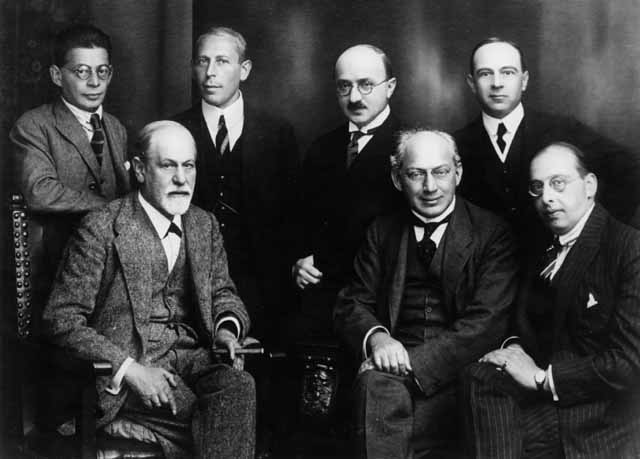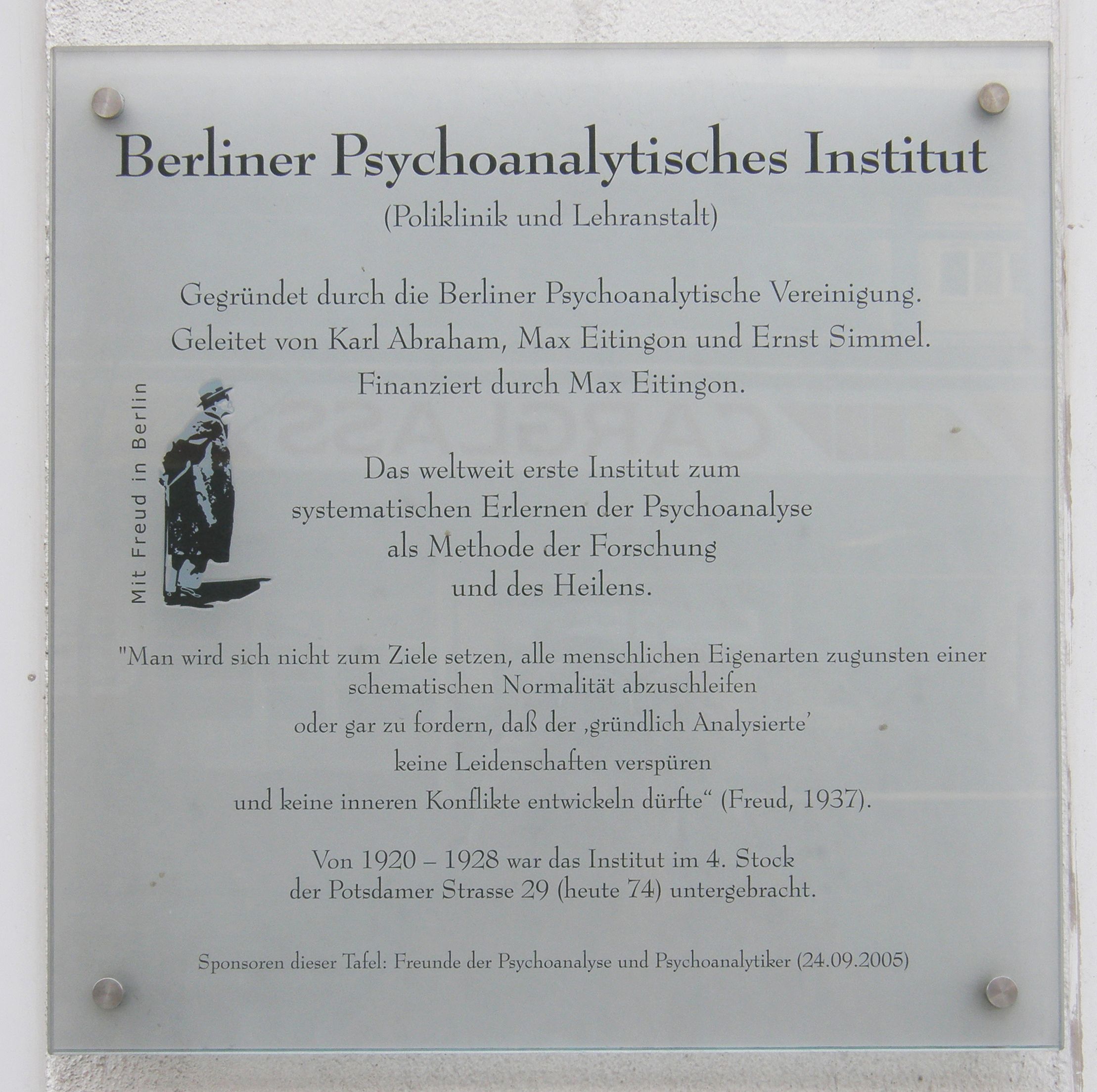|
Ernst Simmel
Ernst Simmel (; 4 April 1882 in Breslau – 11 November 1947 in Los Angeles) was a German-American neurologist and psychoanalyst. Life Born in Breslau (Wrocław), Silesia to a secular Jewish background, Simmel moved to Berlin as a child.Veronika Fuechtner, 'Berlin Soulscapes: Alfred Döblin talks to Ernst Simmel', ch. 1 of ''Berlin Psychoanalytic: Psychoanalysis and Culture in Weimar Republic Germany and Beyond'', University of California Press, 2011, pp.28-31 He studied medicine and psychiatry in Berlin and Rostock. He graduated in medicine in 1908, with a dissertation on dementia praecox. In 1910 he married Alice Seckelson.Ludger M. Hermanns, 'Ernst Simmel', ''International Dictionary of Psychoanalysis'', Gale, 2005Reprinted onlineby answers.com. In 1913 he helped found the Society of Socialist Physicians (VSÄ), and became one of the pioneers of Social Medicine. During World War I he headed a hospital for psychiatric casualties of war in Posen; self-taught in psychoanalysis, ... [...More Info...] [...Related Items...] OR: [Wikipedia] [Google] [Baidu] |
Karl Abraham
Karl Abraham (; 3 May 1877 – 25 December 1925) was an influential German psychoanalyst, and a collaborator of Sigmund Freud, who called him his 'best pupil'. Life Abraham was born in Bremen, Germany. His parents were Nathan Abraham, a Jewish religion teacher (1842–1915), and his wife (and cousin) Ida (1847–1929). His studies in medicine enabled him to take a position at the Burghölzli Swiss Mental Hospital, where Eugen Bleuler practiced. The setting of this hospital initially introduced him to the psychoanalysis of Carl Gustav Jung. Collaborations In 1907, he had his first contact with Sigmund Freud, with whom he developed a lifetime relationship. Returning to Germany, he founded the Berliner Society of Psychoanalysis in 1910. He was the president of the International Psychoanalytical Association from 1914 to 1918 and again in 1925. Karl Abraham collaborated with Freud on the understanding of manic-depressive illness, leading to Freud's paper on 'Mourning and Melanch ... [...More Info...] [...Related Items...] OR: [Wikipedia] [Google] [Baidu] |
Narcissism
Narcissism is a self-centered personality style characterized as having an excessive interest in one's physical appearance or image and an excessive preoccupation with one's own needs, often at the expense of others. Narcissism exists on a continuum that ranges from normal to abnormal personality expression. While there exists normal, healthy levels of narcissism in humans, there are also more extreme levels of narcissism, being seen particularly in people who are self-absorbed, or people who have a pathological mental illness like narcissistic personality disorder. It is one of the traits featured in the dark triad, along with Machiavellianism (psychology), Machiavellianism and subclinical psychopathy. History of thought The term "narcissism" comes from the Roman poet Ovid's ''Metamorphoses'', written in the year 8 AD. Book III of the poem tells the mythical story of a handsome young man, Narcissus (mythology), Narcissus, who spurns the advances of many potential lovers. ... [...More Info...] [...Related Items...] OR: [Wikipedia] [Google] [Baidu] |
Narcissistic Supply
In psychoanalytic theory, narcissistic supply is a pathological or excessive need for attention or admiration from codependents, or such a need in the orally fixated, that does not take into account the feelings, opinions or preferences of other people. The concept was introduced by Otto Fenichel in 1938, to describe a type of admiration, interpersonal support or sustenance drawn by an individual from his or her environment and essential to their self-esteem.. History Building on Freud's concept of narcissistic satisfaction and on the work of his colleague the psychoanalyst Karl Abraham, Fenichel highlighted the narcissistic need in early development for supplies to enable young children to maintain a sense of mental equilibrium. He identified two main strategies for obtaining such narcissistic supplies—aggression and ingratiation—contrasting styles of approach which could later develop into the sadistic and the submissive respectively. A childhood loss of essential supp ... [...More Info...] [...Related Items...] OR: [Wikipedia] [Google] [Baidu] |
New Center For Psychoanalysis
The New Center for Psychoanalysis is a psychoanalytic research, training, and educational organization that is affiliated with the American Psychoanalytic Association and the International Psychoanalytic Association. It was formed in 2005 from the merger of two older psychoanalytic organizations, the Los Angeles Psychoanalytic Society and Institute (LAPSI) and the Southern California Psychoanalytic Institute and Society (SCPIS), which had been founded as a single organization in the 1940s and then split around 1950. History of Psychoanalytic Institutes in Los Angeles Psychoanalytic study groups are documented in the Los Angeles area from the late 1920s, with influence from the Chicago Institute for Psychoanalysis and the Topeka Psychoanalytic Institute The Los Angeles society was initially associated with the California Psychoanalytic Society in San Francisco, which later became the San Francisco Psychoanalytic Society and Institute after the Los Angeles group became independent ... [...More Info...] [...Related Items...] OR: [Wikipedia] [Google] [Baidu] |
Greater Kansas City And Topeka Psychoanalytic Center And Institute
The Greater Kansas City and Topeka Psychoanalytic Center and Institute, also known as the Greater Kansas City Psychoanalytic Center and Institute (GKCPI), is a psychoanalytic center in Kansas City, Missouri, that comprises several interrelated organizations. Currently these are the Kansas City Psychoanalytic Foundation, the Greater Kansas City and Topeka Psychoanalytic Center (GKCTPC), and the Greater Kansas City Psychoanalytic Institute (GKCPI), also known as the Foundation, the center, and the institute. In the early 2000s, the Greater Kansas City Psychoanalytic Institute merged with the older Topeka Psychoanalytic Society. The Psychoanalytic Study Group of Kansas City was incorporated in 1965. During the 1990s it changed its name to the Greater Kansas City Psychoanalytic Society. The Greater Kansas City Psychoanalytic Institute opened in 1996. Topeka Psychoanalytic Society The Menninger Clinic was established by Charles Menninger and his sons Karl and Will Menninger as a ... [...More Info...] [...Related Items...] OR: [Wikipedia] [Google] [Baidu] |
Hitler
Adolf Hitler (; 20 April 188930 April 1945) was an Austrian-born German politician who was dictator of Germany from 1933 until his death in 1945. He rose to power as the leader of the Nazi Party, becoming the chancellor in 1933 and then taking the title of in 1934. During his dictatorship, he initiated World War II in Europe by invading Poland on 1 September 1939. He was closely involved in military operations throughout the war and was central to the perpetration of the Holocaust: the genocide of about six million Jews and millions of other victims. Hitler was born in Braunau am Inn in Austria-Hungary and was raised near Linz. He lived in Vienna later in the first decade of the 1900s and moved to Germany in 1913. He was decorated during his service in the German Army in World War I. In 1919, he joined the German Workers' Party (DAP), the precursor of the Nazi Party, and was appointed leader of the Nazi Party in 1921. In 1923, he attempted to seize governmental ... [...More Info...] [...Related Items...] OR: [Wikipedia] [Google] [Baidu] |
United States
The United States of America (U.S.A. or USA), commonly known as the United States (U.S. or US) or America, is a country primarily located in North America. It consists of 50 states, a federal district, five major unincorporated territories, nine Minor Outlying Islands, and 326 Indian reservations. The United States is also in free association with three Pacific Island sovereign states: the Federated States of Micronesia, the Marshall Islands, and the Republic of Palau. It is the world's third-largest country by both land and total area. It shares land borders with Canada to its north and with Mexico to its south and has maritime borders with the Bahamas, Cuba, Russia, and other nations. With a population of over 333 million, it is the most populous country in the Americas and the third most populous in the world. The national capital of the United States is Washington, D.C. and its most populous city and principal financial center is New York City. Paleo-Americ ... [...More Info...] [...Related Items...] OR: [Wikipedia] [Google] [Baidu] |
Tegel
Tegel () is a locality (''Ortsteil'') in the Berlin borough of Reinickendorf on the shore of Lake Tegel. The Tegel locality, the second largest in area (after Köpenick) of the 96 Berlin districts, also includes the neighbourhood of ''Saatwinkel''. History The Tegel Palace (or Humboldt Palace), originally a Renaissance manor house from 1558 and a hunting lodge of Elector Frederick William of Brandenburg, was bequeathed to the Humboldt family in 1797. Alexander von Humboldt and Wilhelm von Humboldt lived here for several years. In 1824 Wilhelm had the palace rebuilt in a Neoclassical style by Karl Friedrich Schinkel. In the park is a tomb, where Alexander, Wilhelm, and other members of the Humboldt family are buried. From 1927 until 1931 Tegel Palace was the site of a sanatorium, founded by the psychoanalyst Ernst Simmel (1882-1947). From 1898 on Tegel was the seat of the '' Borsig-Werke'' steam locomotive manufacturing company until it moved to Hennigsdorf in Brandenburg in 19 ... [...More Info...] [...Related Items...] OR: [Wikipedia] [Google] [Baidu] |
Schloss Tegel
The Schloss Tegel or Humboldt-Schloss is a country house in Tegel, part of the Reinickendorf district of the German capital Berlin. The brothers Wilhelm and Alexander von Humboldt spent much of their childhood in a former schloss on the site and on the estate, which extends almost as far as Lake Tegel. The present building was built between 1820 and 1824 by Wilhelm von Humboldt to designs by Karl Friedrich Schinkel. It still belongs to the Heinz family, descendants of Wilhelm. It houses the private Humboldt-Museum, open to guided tours during the summer. History Originally built as a Renaissance mansion in 1558, it was converted to a hunting lodge by Frederick William, Elector of Brandenburg. As part of the Tegel estate, it passed to the Humboldt family by marriage in 1766 and became their family seat - Alexander and Wilhelm lived there several years. After their mother Marie-Elisabeth von Humboldt's death, Wilhelm took over the estate in 1797 and had the schloss rebuilt in the ... [...More Info...] [...Related Items...] OR: [Wikipedia] [Google] [Baidu] |
Berlin Psychoanalytic Society
Berlin ( , ) is the capital and largest city of Germany by both area and population. Its 3.7 million inhabitants make it the European Union's most populous city, according to population within city limits. One of Germany's sixteen constituent states, Berlin is surrounded by the State of Brandenburg and contiguous with Potsdam, Brandenburg's capital. Berlin's urban area, which has a population of around 4.5 million, is the second most populous urban area in Germany after the Ruhr. The Berlin-Brandenburg capital region has around 6.2 million inhabitants and is Germany's third-largest metropolitan region after the Rhine-Ruhr and Rhine-Main regions. Berlin straddles the banks of the Spree, which flows into the Havel (a tributary of the Elbe) in the western borough of Spandau. Among the city's main topographical features are the many lakes in the western and southeastern boroughs formed by the Spree, Havel and Dahme, the largest of which is Lake Müggelsee. Due to its location ... [...More Info...] [...Related Items...] OR: [Wikipedia] [Google] [Baidu] |
Berlin Psychoanalytic Institute
The Berlin Psychoanalytic Institute (later the Göring Institute) was founded in 1920 to further the science of psychoanalysis in Berlin. Its founding members included Karl Abraham and Max Eitingon. The scientists at the institute furthered Sigmund Freud's work but also challenged many of his ideas. History The Berlin Psychoanalytic Institute grew from the Psychoanalytic Polyclinic (''psychoanalytische Poliklinik'') founded in February 1920. The Polyclinic allowed access to psychoanalysis by low-income patients. Only some 10% of its income came from patients' fees; the rest was provided personally by Max Eitingon. It introduced the three-column, or "Eitingon", model for the training of analysts (theoretical courses, personal analysis, first patients under supervision), which was later adopted by most other training centers. In 1925, Eitingon became chair of the new International Training Committee of the International Psychoanalytic Association. The Eitingon model remains standard ... [...More Info...] [...Related Items...] OR: [Wikipedia] [Google] [Baidu] |





